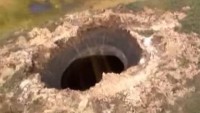Seoul Still Clueless What Caused Sidewalk Sinkhole
| Raymond Legaspi | | Feb 25, 2015 11:25 AM EST |
Seoul city authorities are still facing a blank wall on what caused the portion of a sidewalk near Yongsan station to collapse, sending two people tumbling into a 3-meter sinkhole on Friday.
A local bus camera recorded the moment the sinkhole parted beneath two pedestrians after they got off a bus.
Like Us on Facebook
The two were rushed to a nearby hospital and treated for scratches and minor injuries, South Korea's Yonhap News Agency reported.
The Yongsan Fire Department said the sinkhole opened up next to the site where Daewoo Engineering is constructing a two-building, 39-story apartment project.
City officials did not take any chances and asked the construction near the sinkhole to be stopped temporarily.
Authorities said Daewoo could be liable for flawed construction management, authorities said.
The Korean Geotechnical Society is also looking into the cause of the sinkhole while a metropolitan agency is examining the site for other possible sinkholes.
Sinkholes usually take thousands of years to take shape and differ vastly in size, experts say.
The deepest sinkhole is China's 662-meter Xiaozhai Tienkeng.
Egypt's Qattara Depression is about 80 kilometers by 121 kilometers in area. Usually, sinkholes are only a few meters in size.
There are indicators of possible sinkholes in cities. These include windows and doors failing to shut properly or cracks appearing in the support structure of houses.
In other cases, movement in the ground can be detected. Torrential rains or clogged drainpipes can lead to a collapse.
Experts say sinkholes are usually the result of what are scientifically known as Karst processes. Holes form when acidic water dissolves a sediment of rock beneath the ground.
The topsoil sinks into the cavity when the weight above it is too heavy. This layer is usually a soluble carbonate rock, such as chalk or limestone.
Usually, rainfall settles in the soil, taking in carbon dioxide and processed by decaying vegetation. This results in acidic water that settles in the soluble rock.
©2015 Chinatopix All rights reserved. Do not reproduce without permission
EDITOR'S PICKS
-

Did the Trump administration just announce plans for a trade war with ‘hostile’ China and Russia?
-

US Senate passes Taiwan travel bill slammed by China
-

As Yan Sihong’s family grieves, here are other Chinese students who went missing abroad. Some have never been found
-

Beijing blasts Western critics who ‘smear China’ with the term sharp power
-

China Envoy Seeks to Defuse Tensions With U.S. as a Trade War Brews
-

Singapore's Deputy PM Provides Bitcoin Vote of Confidence Amid China's Blanket Bans
-

China warns investors over risks in overseas virtual currency trading
-

Chinese government most trustworthy: survey
-

Kashima Antlers On Course For Back-To-Back Titles
MOST POPULAR
LATEST NEWS
Zhou Yongkang: China's Former Security Chief Sentenced to Life in Prison

China's former Chief of the Ministry of Public Security, Zhou Yongkang, has been given a life sentence after he was found guilty of abusing his office, bribery and deliberately ... Full Article
TRENDING STORY

China Pork Prices Expected to Stabilize As The Supplies Recover

Elephone P9000 Smartphone is now on Sale on Amazon India

There's a Big Chance Cliffhangers Won't Still Be Resolved When Grey's Anatomy Season 13 Returns

Supreme Court Ruled on Samsung vs Apple Dispute for Patent Infringement

Microsoft Surface Pro 5 Rumors and Release Date: What is the Latest?











